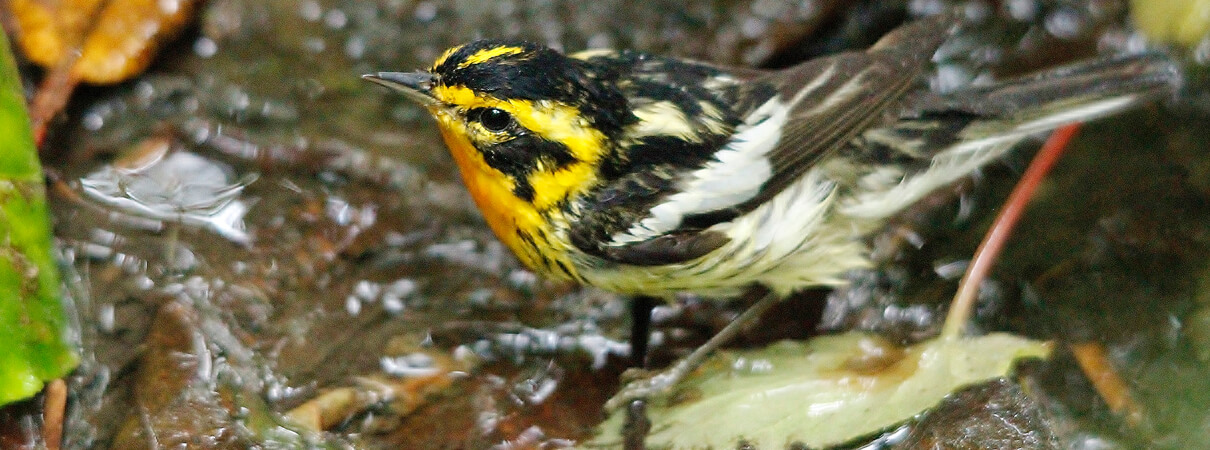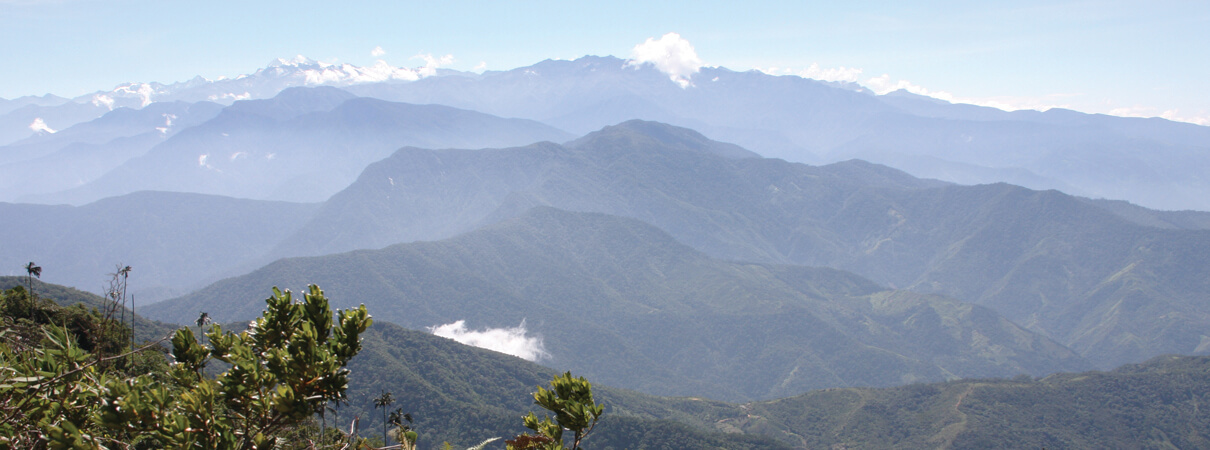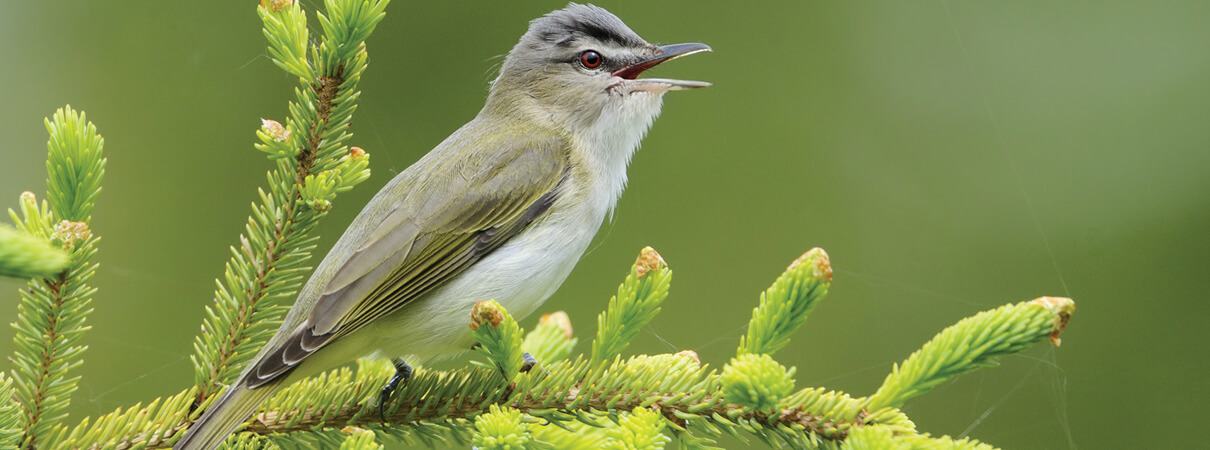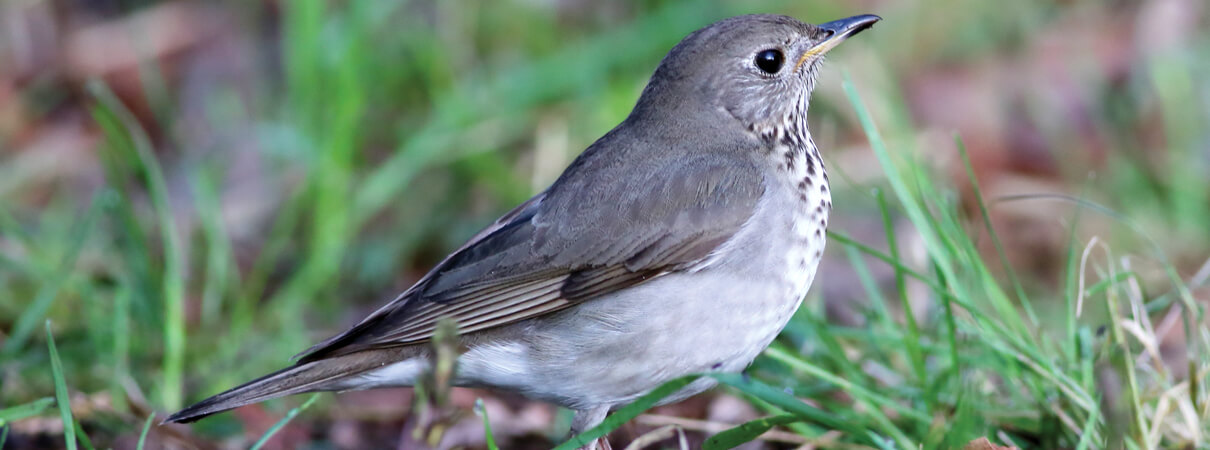Stopover Habitats and What Birds Need on Migration
Migration is possibly the riskiest activity many birds undertake in their lives, and yet billions of birds representing nearly 300 species migrate between North America and tropical regions to the south every spring and fall.

Blackburnian Warblers are among the many migratory songbirds that rely on healthy stopover habitats to refuel during their twice-yearly migratory journeys. Photo by Benjamin Skolnik
Their twice-yearly journeys can span thousands of miles and are fraught with dangers and unfamiliar places. Evolution and adaptation minimize some risks but work too slowly to help species respond to today's rapidly changing conditions — such as habitat loss and the effects of climate change.
Human population growth, and the associated increase in development and demands on natural resources, has put tremendous pressures on the habitats needed by migratory birds throughout the Americas. As a result, the number of migratory birds is declining year after year. It's part of a disturbing global pattern, raising concerns that the phenomenon of migration — and the capacity of our ecosystems to support it — could disappear.
We cannot speed a species' evolutionary response to threats from land use or climate change, but we can help slow or reverse the spread of those threats. First, however, we need to better understand migratory birds' needs once they leave North America.
Partners in Conservation
In July 2016, the Cornell Laboratory of Ornithology and American Bird Conservancy signed an agreement establishing the Science to Action partnership. Through this partnership, the organizations are uniting the Cornell Lab's science with ABC's conservation approach in a joint effort to address the decline of migratory birds in the Americas.
One of the partnership's initial collaborations employs new research from the Neotropical Flyways Project, which is led by SELVA in Colombia and aims to identify critical stopover habitats for migratory birds. Cornell and ABC will use that data to help guide investment in effective conservation strategies. Among other things, this effort will provide essential information as ABC identifies new BirdScapes locations.
What Happens South of the Border?
Many of North America's migratory bird species spend much of their time in Mexico and farther south — either on their wintering grounds or in transit between them and their more northerly breeding grounds. For example, many species of warblers, thrushes, tanagers, and cuckoos traverse vast stretches of the Caribbean Basin or Central and northern South America to reach their wintering grounds in the Andes, the Amazon Basin, or even farther south.

The Sierra Nevada de Santa Marta — an isolated mountain range on Colombia's Caribbean coast — is home to an exceptional concentration of resident birds, and also provides essential habitat for migrating songbirds, such as Red-eyed Vireo, Gray-cheeked Thrush, Blackburnian Warbler, and Tennessee Warbler, among others. Photo by Larry Thompson
In spite of this large area's critical importance to birds, we know very little about where, when, and why migratory landbirds stop in the Neotropics (the region that extends from southern Mexico through Central America and the Caribbean, and into South America). Our knowledge of migration is biased by studies that focus on the United States and Canada. As a result, the Neotropics have been described as a “black box” in our knowledge of bird migration, holding essential secrets to which we don't yet have access. That glaring knowledge gap limits our ability to design effective conservation strategies for all stages of migratory birds' annual life-cycle.
The Need for Knowledge
In no area of migratory birds' life-cycle is our understanding so limited as in stopover habitats. We know that these sites provide crucial resources: food that fuels their long-haul flights, safe places to roost and rest, and somewhere to ride out unfavorable conditions or events such as the tropical storms that sometimes rage through the Caribbean during fall migration.

Biologists have used geolocators — tiny tracking devices that use light levels to approximate a bird's location — to show that Red-eyed Vireo make long refueling stops in northern Central America during their migration. Photo by Tim Zurowski
Like links in a chain, these stopover sites sustain birds' remarkable long-distance migrations. They are typically resource-rich — some birds literally double their body weight at these sites, building fat stores that will sustain them as they fly thousands of miles across continents and oceans.
Researchers long thought these refueling stops could be made at any point along the birds' migratory journeys, but recent studies suggest otherwise. We now know that individual birds often take long, multi-day breaks at just three or four key points during their migration.
These findings highlight an urgent need to re-evaluate how we approach the conservation of migratory birds, and especially how we think about their needs during migration. This need is especially apparent in the Neotropics, where the funnel-shaped geography of Mexico and Central America acts as a bottleneck, concentrating millions of migratory birds. SELVA, ABC, and the Cornell Lab have made it a conservation priority to identify and protect these tropical habitats that sustain migration for some of North America's most-loved species.
It's time to open the black box.
A Peek Inside the Black Box
What we do know about stopover sites reinforces just how important these Neotropical regions can be to the survival of migratory birds. For example, Purple Martin, Swainson's Thrush, and Wood Thrush all make extended fall stopovers on the Yucatán Peninsula. And geolocators — tiny tracking devices that use light levels to approximate a bird's location — have revealed that both Red-eyed Vireo and Swainson's Thrush make long refueling stops in northern Central America.
Recent studies by SELVA in the Sierra Nevada de Santa Marta — an isolated mountain range on Colombia's Caribbean coast — are even more striking. The region contains an exceptional concentration of resident birds found nowhere else. But we now know the area provides essential habitat for Red-eyed Vireo, Gray-cheeked Thrush, Blackburnian Warbler, and Tennessee Warbler during their spring migration. Veery also stop here for as many as nine days in the fall, increasing their body mass by approximately 30 percent. These impressive energy stores will sustain them on their long flight to their Amazonian wintering grounds, a distance of more than 1,200 miles.

Gray-cheeked Thrushes may fly nonstop approximately 2,000 miles from their stopover habitat in Colombia's Sierra Nevada de Santa Marta. Photo by Mike Parr
The story of the Gray-cheeked Thrush illustrates the crucial importance of these stopover sites. This species makes a marathon journey each spring from the tropical forests of Amazonia to the northernmost extent of Canada's boreal forest and sometimes as far as Siberia. In the fruit-rich forests of Colombia's Sierra Nevada de Santa Marta, the thrushes build fat reserves during two weeks of frenzied feeding before crossing the Caribbean Sea. Radio transmitters reveal that many of the thrushes fly nonstop for up to 2,000 miles after departing the Sierra Nevada de Santa Marta, safely flying over the Caribbean and the Gulf of Mexico to reach the heart of North America.
Studies in Colombia offer other key lessons. For example, we now know that migratory landbirds are far more abundant in certain stopover habitats than in others and that different habitats provide different fueling opportunities for birds. Variations in habitat quality and food availability can make the difference between individuals successfully crossing a water barrier, needing to take a longer route or make additional stopovers, or — worst of all — running out of fuel while over water.
Protecting the Stopover Habitats
As researchers are learning about the importance of certain tropical regions for migration, new concerns are being raised about threats to specific sites and vital habitats. Habitat loss continues to be the leading threat to migratory bird populations throughout their ranges. When birds are highly concentrated during migration, loss or degradation of critical habitats for them may contribute disproportionately to overall population declines.
Much of the research to date indicates that many landbirds stopping over in the Neotropics rely on native forests, from the foothills of the Sierra Nevada de Santa Marta to lowland tropical wet and dry forests along the coasts. Yet across the Neotropics, these forests are under severe threat from expanding agriculture and development; several of the major stopover regions identified to date are experiencing high rates of deforestation.

Deforestation — such as what can be seen on this denuded slope in Colombia — and other forms of habitat loss are leading threats to migratory birds, which rely on healthy habitats at both ends of their journeys as well as at one or more stopover sites along their migratory routes. Photo by Larry Thompson
The deadly effects of collisions with buildings, communication towers, wind turbines, and other structures may also be magnified in these areas where millions of birds congregate. We know that astounding numbers of birds — up to one billion a year — are thought to perish through glass collisions in North America alone, but we don't yet have equivalent data from the Central American bottleneck and other important migratory corridors. The loss of life here may be as great — or greater — than that experienced in North America. Meanwhile, urban and resort development along coastlines, along with a proliferation of wind-energy and communications infrastructure, pose major challenges for migratory bird conservation.
Despite our growing understanding of migratory strategies and stopover use, as well as the various threats birds face, we have only scratched the surface when it comes to the needs of migratory landbirds. And while continued and future research will reveal additional secrets from the black box, some habitats and regions are so threatened that we cannot afford to wait.
This is why the Cornell Lab and ABC are working together with SELVA to incorporate what we already know into full life-cycle bird conservation plans, and to put these plans into action through BirdScapes. It's also why we join together with partners on the ground across the Neotropics — partners like SELVA, FUNDAECO, Pronatura Noreste, Fundación Jocotoco, and many others — to ensure our conservation actions are sustainable over the long term.
Saving the great avian migration of the Western Hemisphere requires nothing less than this large-scale, highly collaborative effort. Because losing migration is a risk we cannot afford to take.
Ken Rosenberg is Applied Conservation Scientist at the Cornell Lab of Ornithology and is leading the Science to Action partnership. Nick Bayly and Camila Gómez have led SELVA's migratory bird research program since 2009 and hope to uncover many more secrets through the Neotropical Flyways Project.


















































